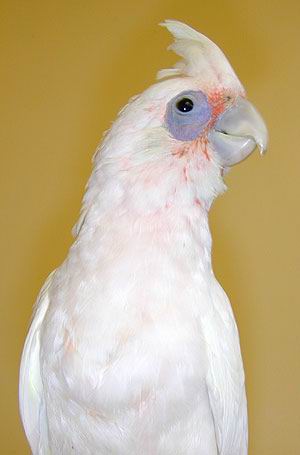Cockatoo - Bared eyed
Little Corella, Bare Eyed Scientific Name: Cacatua pastinator pastinator
Wed, 2nd July, 2025 - 7:14 pm GMT
Sponsor Ads:

Alternative Name
Little Corella, Bare Eyed Scientific Name: Cacatua pastinator pastinatorBasic Info
With grayish white feathers and curved, short white beaks, s.sanguinea Little Corellas are attractive birds. Their periopthalmic rings are blue-gray, and they have less pale red coloration about their beaks than other Little Corellas. Generally, there is a pale yellow coloring in the nostril region, which is more noticeable than the pink. Their feathers occasionally have a pinkish orange tinge to their bases, which is especially evident about the bird's lores. The heads of Little Corellas are topped with a lovely curving crest. The only difference between the Little Corella sexes is in the size of the body or head, though often it is still very difficult to tell and DNA sexing is required.
Health
Bare Eyed Corella, like other Little Corellas often pluck their feathers, so be sure to provide lots of toys and branches for them to chew on, fending off boredom. Because they spend so much time on the ground, Little Corellas are prone to intestinal worms and fungal infections. The majority of these can be prevented by proper hygiene. Psittacine Beak and Feather Disease is another common problem, and is incurable. Birds with the disease have black feathers and fragile beaks, which do not heal. The disease is transmitted through feces, and infected birds must be put down. Breeding In the wild, the majority of Little Corellas breed between June and October, though there is no specific breeding season. In captivity, Little Corellas will need a nesting log of about a meter in length with a 35-centimeter internal diameter. It may be place vertically or at a slant, and you should provide peat moss, dirt and wood shavings as nesting material. Make about a six to eight inch layer of nesting, as many Little Corellas will like to excavate their nests somewhat. Although rarely, Little Corellas have bred at two years of age, but they usually mate for the first time at four or five years and many pairs will not clutch until they are six or seven. A clutch consists of one to three eggs, which incubate for approximately 26 days. The young fledge at around 56 days of age.Habitat
N/ABehavior
One of the lighter colored subspecies of Little Corella, the Bare Eyed Cockatoo, also known as the Bare Eyed Corella may not be so striking in facial coloration as other subspecies. The Bare Eyed Corella will make a subtly beautiful and overtly sweet friend. The Bare Eyed Cockatoo is generally sweet and can be taught to talk and do tricks! They are, in fact, considered to be the best talkers of all Cockatoos, but be careful; they are also good at escaping! Little Corellas love to chew and can often bite their way out of wire cages! In the wild, Little Corellas eat seeds, insects, bulbs and fruit. They like open grassland or open forest and are usually found near water. Little Corellas are very vocal in the wild and do not have a set home range; rather, they are nomadic. In captivity, your Little Corella needs fresh water at all times and should be fed on a good parrot mix supplemented with fresh fruits and vegetables. The s.sanguinea subspecies of Little Corella is quite playful and is often described as "cheeky"! They are extremely intelligent and will perform crazy or amusing antics in order to get your attention! S. sanguinea Little Corellas do very well when kept in pairs. A single bird will do fine in a cage of at least 800 by 600 by 1200 millimeters in dimension. Little Corellas will thrive, however, in large aviaries with steel frames and very heavy wire. These should be about two by two by six meters in dimension. In the wild, Little Corellas build their nests in holes of tall trees or hollow branches and line them with soft wood shavings. The courtship display of Little Corellas is typical of Cockatoos; the male bobs his head and screeches at his intended female while spreading his wings and tail and holding his crest erect. Little Corellas intending to breed will pay a great deal of attention to their nesting site, loitering around the entrance and inside, and chewing on the entrance! All in all the Bare Eyed Cockatoo makes any excellant pet for anyone who is familiar with cockatoos.Origin
AustraliaHistory
The sanguinea sanguinea subspecies of Little Corella is found in Northern Australia. They have long been valued as pets. They are also called Bare-eyed Corellas.Common Foods
N/ASponsor Ads:
You never know how many friends you have until you own a house at the beach. -- Unknown
Cockatoo - Bared eyed
Coded by: BGID® | ALL RIGHTS RESERVED Copyright © 2000-2025
Disclaimer | Privacy | Report Errors / Contact | Credits

 Preparing For China. China is growing their military. China Military Technology - can it keep up with the US?
Preparing For China. China is growing their military. China Military Technology - can it keep up with the US?  versus
versus 

 versus
versus 
 This Thread is about the North Korean Military itself - the kind of army, navy, and air force they have.
This Thread is about the North Korean Military itself - the kind of army, navy, and air force they have. 
 versus
versus 
 versus
versus  versus
versus